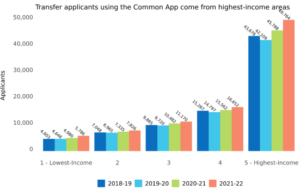For the past four academic years, an overwhelming proportion of students submitting transfer applications via the Common App were from a high socioeconomic and were continuing generation and non-underrepresented students, according to a new report.
“Common App for transfer: a four-year retrospective” found that 55% of transfer applicants came from ZIP codes in the top quintile of median household income (20%). In the 2021-22 academic year alone, the top quintile of students initiated a transfer application 33,000 times more than the group with the second-most transfer, which happened to be the second-highest income quintile.
While school transfers are aimed at boosting education equity, students who leverage it the most seems to correlate with the student’s wealth.
To determine a student’s socioeconomic status, the Common App linked ZIP code-level median household income data from the American Community Survey to each U.S. applicant.
“These findings are somewhat concerning given that the college transfer process should reflect educational mobility for all students, especially for historically excluded groups,” wrote the report’s authors. “Our findings suggest that the transfer application process reflects the inequitable state of higher education.”

More from UB: Minnesota’s “bold action to make college affordable” results in free tuition
Similarly, the number of students in the last academic year who applied for a transfer not from an unrepresented minority (URM) was 53,000 more than those from a URM. However, their rate of applications has increased at the same rate (9%) over the past four academic years.
Additionally, the rate of continuing-education students applying for a transfer has increased by 12%, higher than first-generation students’ 3%. Almost 40,000 more continuing-education students applied for one during last year’s academic cycle than first-generation students,
Applicants from less-resourced backgrounds can’t keep up with their more well-to-do counterparts. Recent data from the National Student Clearinghouse Research Center found that upward transfers, such as those from two- to four-year institutions, declined by 7.5% during the 2021-22 academic year.
Because the Postsecondary Education Data System (IPEDS) does not collect data on non-first-time applicants, there is no systemic, national data set for the Common App to analyze these results over an extended period. This data is “largely novel,” and they will continue to track this trend moving forward.







